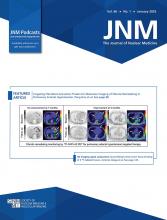Visual Abstract
Abstract
The VISION and TheraP trials introduced different PET-based criteria for patient selection for treatment with 177Lu-PSMA-617 (LuPSMA). TheraP used a higher prostate-specific membrane antigen (PSMA) uptake threshold than VISION and required 18F-FDG PET to exclude patients with discordant findings. Although the screen-failed patients had shorter overall survival (OS) than those treated with LuPSMA, it remains unclear whether their outcomes might have been modified if they had been exposed to LuPSMA. In this study, we evaluated associations between the TheraP eligibility criteria and subgroups and the treatment outcomes of patients who were deemed suitable and treated on the basis of VISION criteria. Methods: Consecutive patients who were treated with LuPSMA and who underwent pretreatment PSMA and 18F-FDG PET were classified as TheraP-eligible (TheraP-E) and TheraP-ineligible (TheraP-I), the latter of which were subclassified as low PSMA or discordant. Odds ratios for an at least 50% decline in prostate-specific antigen (PSA50) were computed using logistic regression, and hazard ratios (HRs) for PSA progression-free survival (PSA-PFS) and OS were computed using Cox regressions. Multivariable analyses were adjusted for baseline imaging and clinical parameters. Results: Of 75 patients, 31 (41%) were deemed TheraP-I; of those, 24 were subclassified as having discordant disease. TheraP-I patients had a lower PSA50 rate than that of TheraP-E patients (28% vs. 67%; odds ratio, 0.19; 95% CI, 0.06–0.52; P = 0.002) and a higher risk of PSA progression (HR, 2.0; 95% CI, 1.2–3.3; P = 0.007). OS in the TheraP-I group was numerically shorter than in the TheraP-E group, but the comparison was only marginally significant (10.4 mo vs. not reached; HR, 1.9; 95% CI, 1.0–3.7; P = 0.054). TheraP-I patients with low PSMA had no significantly different risk of death (P = 0.9) from that of TheraP-E patients, but those with discordant findings had higher risk of death (HR, 2.3; 95% CI, 1.1–4.6; P = 0.02). Discordant disease remained prognostic for OS after adjusting for baseline imaging and clinical parameters (HR, 3.0; 95% CI, 1.3–6.8; P = 0.01). Conclusion: In VISION-eligible patients who were treated with LuPSMA, TheraP-I patients with discordant findings had lower PSA50, PSA-PFS, and OS. Our study suggests that the shorter OS of TheraP-I patients is mainly driven by the presence of discordant disease.
Footnotes
Published online Nov. 14, 2024.
- © 2025 by the Society of Nuclear Medicine and Molecular Imaging.
This article requires a subscription to view the full text. If you have a subscription you may use the login form below to view the article. Access to this article can also be purchased.
SNMMI members
Login to the site using your SNMMI member credentials
Individuals
Login as an individual user








